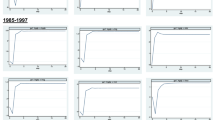Abstract
The consequences of exchange rate and monetary policies are investigated under two foreign exchange regimes. The analysis is motivated by the experiences in sub-Saharan Africa. The supply side of the open economy model developed by Buffle (1986) is modified to take into account the import dependency of the region. In the first regime, with endogenous foreign savings, overvalued exchange rate and expansionary monetary policy tend to increase the current account deficit. In the second regime, when intermediate imports are rationed to handle the foreign exchange shortage, overvaluation and monetary expansion are shown to be likely sources of output contraction. The cost of policy reorientation is reduced investment.
Similar content being viewed by others
References
Bacha, E. (1984) “Growth with Limited Supplies of Foreign Exchange: A Reappraisal of the Two Gap Model.” In M. Syrquin et al. (eds).Economic Structure and Performance, New York: Academic Press, 263–280.
Buffie, E. (1986) “Devaluation, Investment and Growth in LDCs,”Journal of Development Economics 20, 361–379.
Chhibber, A., J. Cottani, R. Firuzabadi, and M. Walton (1989) “Inflation, Price Control and Fiscal Adjustment in Zimbabwe,” PPR Working Paper No. 192, Country Economics Department, The World Bank.
Davies, R. (1988) “Trade, Trade Management and Development in Zimbabwe,” Working Paper in Economics No. 3, Department of Economics, University of Zimbabwe.
Davies, R. and J. Rattsø (1993) “Zimbabwe.” In Lance Taylor (ed),The Rocky Road to Reform: Adjustment, Income Distribution, Politics and Growth in the Developing World. Cambridge: MIT Press, 321–342.
Green, R. and X. Kadhani (1983) “Zimbabwe: Transition to Economic Crises, 1981–83: Retrospects and Prospects,”World Development 14, 1059–1083.
Helleiner, G. (1990) “Structural Adjustment and Long-Term Development in Sub-Saharan Africa,” Development Studies Working Papers No. 18, Centro Studi Luca d'Agiiano-Queen Elizabeth House, Torino and Oxford.
Kayizzi-Mugerwa, S. (1990) “Growth from Own Resources: Zambia's Fourth National Development Plan in Perspective,”Development Policy Review 8, 59–76.
Krugman, P. and L. Taylor, (1978) “Contractionary Effects of Devaluation,”Journal of International Economics 8, 445–456.
Lizondo, J. Saul and P.J. Montiel (1989) “Contractionary Devaluation in Developing Countries: An Analytical Overview,”IMF Staff Papers 36, 182–227.
Moran, C. (1989) “Imports Under a Foreign Exchange Constraint,”World Bank Economic Review 3, 279–295.
Ndulu, B. (1986) “Investment, Output Growth and Capacity Utilization in an African Economy: The Case of Manufacturing Sector in Tanzania,”East Africa Economic Review 2, 14–30.
Ndulu, B. (1990) “Growth and Adjustment in Sub-Saharan Africa.” Mimeo, Department of Economics, University of Dar-es-Salaam.
Ndulu, B. (1993) “Medium Term Growth in Tanzania.” In Lance Taylor (ed),The Rocky Road to Reform: Adjustment, Income Distribution, Politics and Growth in the Developing World. Cambridge: MIT Press, 343–364.
Rakshit, M. (1992) “Trade and Exchange Rate Policy with a Binding Foreign Exchange Constraint.” National Institute of Public Finance and Policy, New Delhi.
Rattsø, J. (1993) “The Asymmetric Relation Between Sub-Saharan Africa and the Rest of the World: A Theoretical Analysis of the Role of Import Compression,”East Africa Economic Review 8, 1, 1–11.
Wheeler, D. (1984) “Sources of Stagnation in Sub-Saharan Africa,”World Development 12, 1–23.
World Bank (1989)Sub-Saharan Africa: From Crisis to Sustainable Growth. Washington, D.C.: IBRD.
World Bank (1990)Report on Adjustment Lending II: Policies for the Recovery of Growth. Washington, D.C.: IBRD.
Author information
Authors and Affiliations
Rights and permissions
About this article
Cite this article
Rattsø, J. Devaluation and monetary policy with import compression. Open economies review 5, 159–175 (1994). https://doi.org/10.1007/BF01000485
Issue Date:
DOI: https://doi.org/10.1007/BF01000485




